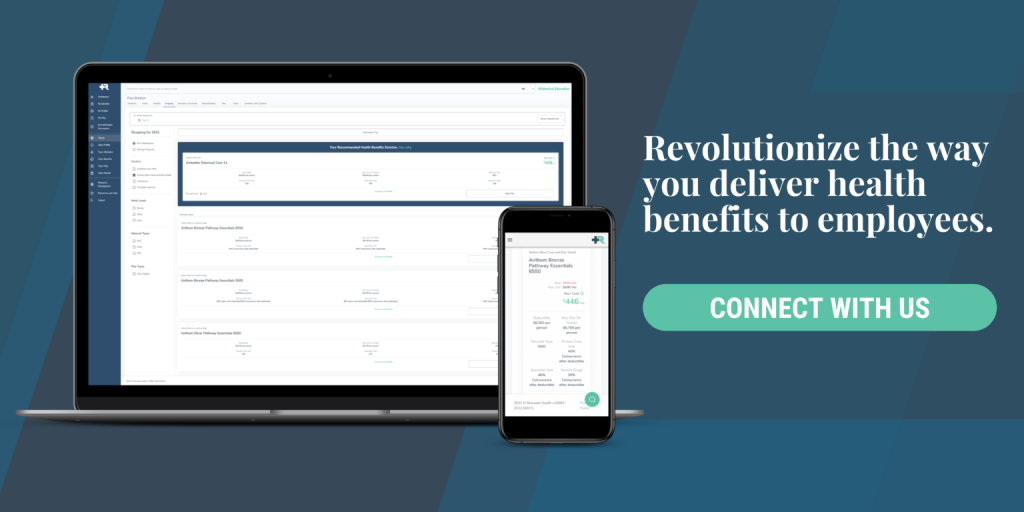1 in 2 Americans have access to health insurance through an employer, accounting for 151,000 million people. 87% of all large and mid-sized employers offer only traditional group health plans. Though the scope is great, the options for both employers and employees have remained fairly limited. In 2020, a brand new method for employers to offer health benefits was introduced in the form of Individual Coverage Health Reimbursement Arrangements (ICHRA). This solution followed an executive order from October 2017 and underwent rigorous due process between relevant government departments, such as the DOL, HHS, IRS, and more. The result was Individual Coverage HRAs, or for short, “ICHRA” (pronounced ick-ruh). The Department of Labor has projected that over the next 3 years, 800,000 employers and 11 million employees will move away from traditional group plans over to an ICHRA. The following is a simple comparison between traditional group plans and Individual Coverage HRAs:
Quick Review: What is an Individual Coverage HRA?
An Individual Coverage HRA (ICHRA) is an employer-funded Health Reimbursement Arrangement (HRA) that employers of any size or industry can use to reimburse employees tax-free for qualified medical expenses.
1. Budgets Instead of Products
Traditional group plans revolve around specific insurance products selected by the employer. An Individual Coverage HRA (ICHRA), on the other hand, moves away from singular insurance products. Instead, ICHRAs allow employers to offer a spendable allowance to employees to shop for individual health insurance.
This provides increased budget control to the employer and spending flexibility for the employee. The employer can organize their employees by category, and then provide different amounts to each categories. When structured correctly, an ICHRA can also fulfill the large employer mandate.
2. Improved Selection of Plans
A recent study of employers in higher education found that only 1% of employers offered up to 4 health insurance options for employees. Oftentimes, traditional group plans require at least 50% participation. This means employees have very few options to choose from, but they must select from its limited choices.
Individual Coverage HRAs dynamically improve the selection of health insurance. The individual marketplace typically has anywhere from 15 to 50 unique plan designs available for employees to select from. When it comes to health insurance, one size never fits all. Moving away from only offering 1 to 3 options, ICHRA gives employees the opportunity to find what fits their unique needs best.

3. Employee Personal Choice
All these factors lead us to ponder the fundamental principle of employee choice:
Why should the employer pick a healthcare plan for employees?
Should the employer bear the weight of trying to find a plan that works for everyone?
Why not just provide the budget to spend, point them in the right direction, and allow employees to choose for themselves?
This is what Individual Coverage HRAs are all about. ICHRA was fundamentally designed to allow people to have freedom of choice. ICHRA gives individuals the choice between products, which means insurance carriers will need to follow market trends in order to stay competitive. Both price and plan designs will follow.
Last year, individual products increased by 0% in-aggregate and on-average in the United States. Whereas traditional group plans increased anywhere from 5-15% nationally.
Additionally, 78% of individual health insurance carriers have acknowledged that, in order to remain competitive, they will need to increase the quantity and improve the quality of their individual plan options. This means personal choice is not only better with ICHRA now, but will continue to improve against traditional group plans.
4. ICHRA+™
Individual Coverage HRAs are the most significant change to health insurance since the enacting of the Affordable Care Act. Just like every health benefits option, ICHRAs do have some limitations. Primarily, it’s difficult for an employer to leverage tax credit discounts on individual plans for those who qualify for them, while also leveraging tax-free options for those who do not.
Thankfully, Remodel Health has released a proprietary blend consisting of an Individual Coverage HRA, plus our exclusive wage increase model. We call it ICHRA+™.
ICHRA+™ harnesses the budget model, improving plan choice for employees, while also helping employees who are eligible for other programs (and therefore, tax incentives) to take advantage of those things. Combining wage increases with Individual Coverage Health Reimbursement Arrangements (ICHRA) ensures leveraging both sides of the equation.
If you are interested in learning more about Individual Coverage HRAs or ICHRA+™ and how they can help you cut costs and care well for your team, be sure to check out our full ICHRA guide. This guide will help you understand the key details of these new health reimbursement arrangements; you can even run your own online savings estimate using our free online calculator tool!
Our expert team of benefits coaches would be happy to run a full evaluation of all your options, whether its alternative group plans, self-funded plans, or ICHRA — shoot us an email at [email protected] and get connected.

Important Notice: Remodel Health does not intend to provide specific insurance, legal, or tax advice. Remodel Health always recommends to consult with your own professional representation to properly evaluate the information presented and its appropriate application to your particular situation.
